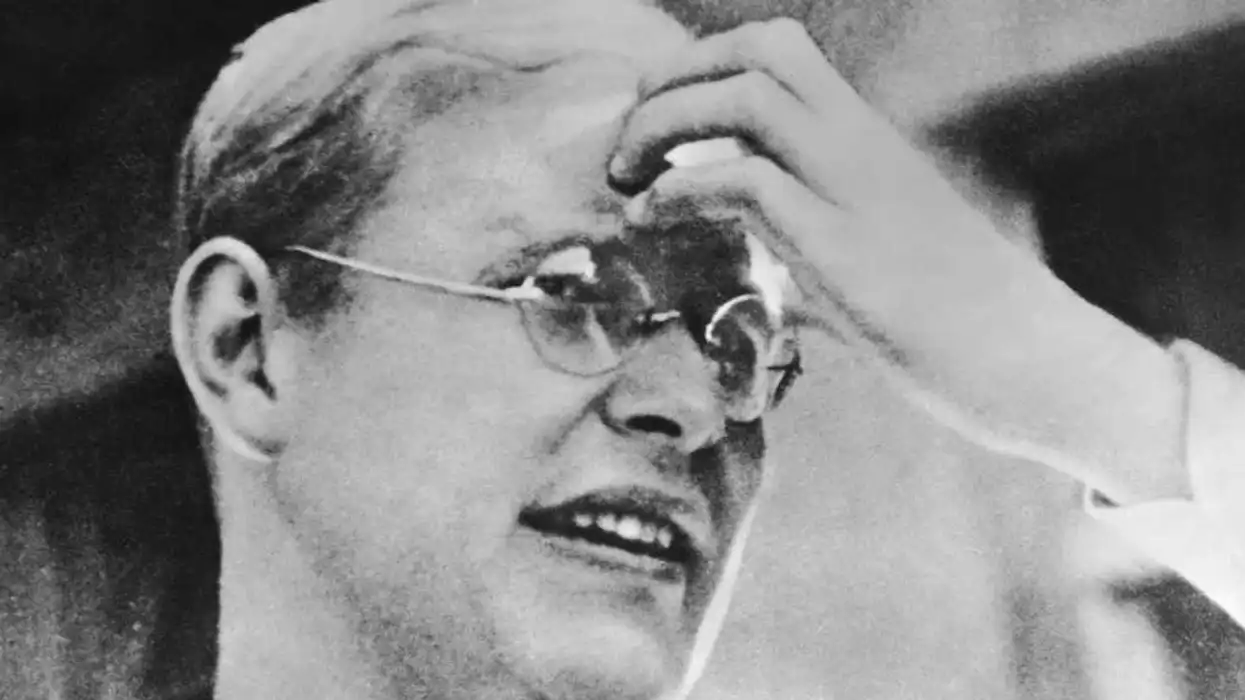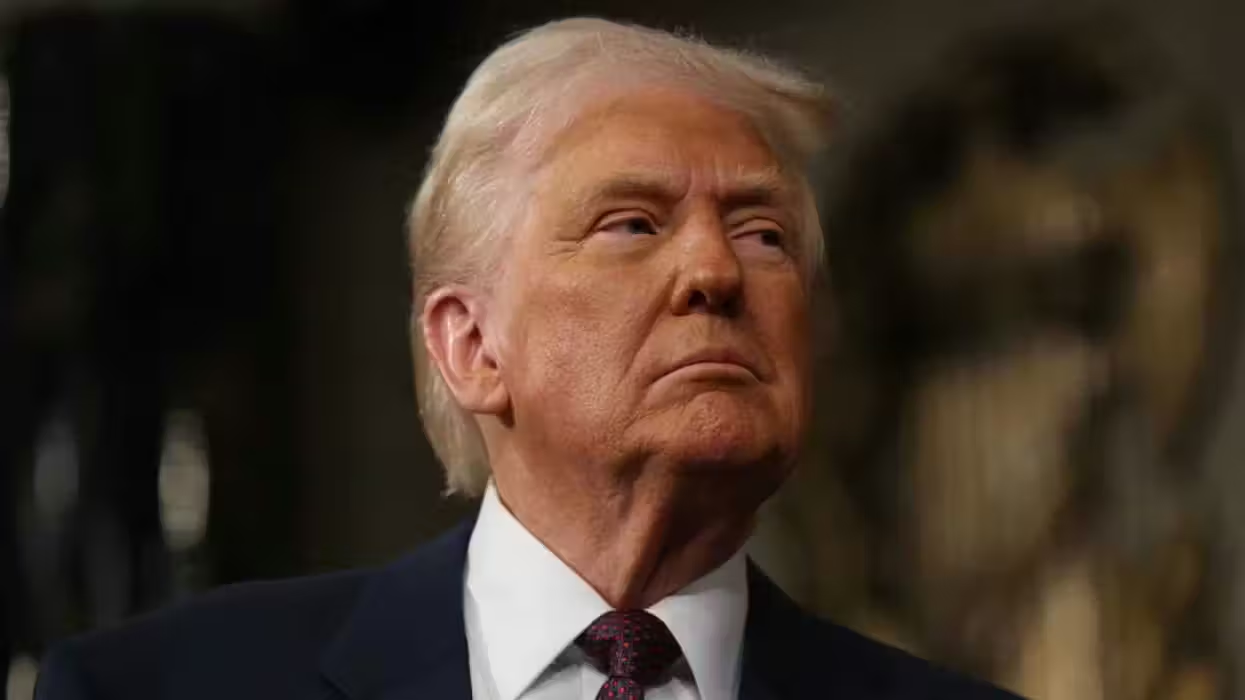
© 2026 Blaze Media LLC. All rights reserved.
Remotely controlled drones can't film for commercial use.
Editor's note: Antimedia is a Norwegian company fully licensed to operate drones in Norway and Europe, and shot this footage legally overseas. CineDrones is a U.S. company hoping to get similar licenses to film in America.
-
Know that feeling in your gut when you peek over the edge of a cliff? This video captures it in spades with a "Cinedrone." But the FAA still says this kind of footage, if filmed for commercial purposes, is still illegal in the United States.
Antimedia, a California-based production company, published the roughly three-minute video that boasts some breathtaking shots only a drone-mounted-camera could capture.
 A Cinedrone, a movie-quality camera mounted on a remotely piloted drone, captures the moment two base jumpers hurl off of a cliff (Image source: Vimeo screenshot)
A Cinedrone, a movie-quality camera mounted on a remotely piloted drone, captures the moment two base jumpers hurl off of a cliff (Image source: Vimeo screenshot)
Mike Fortin, CineDrones president, has heartburn over the Federal Aviation Administration's regulations for small, "unobtrusive" remotely piloted systems.
"As much as this administration talks about wanting to support small businesses, these regulations are killing our ability to get ahead of a billion-dollar industry," Fortin said. "They are taking away people's livelihood."
The U.S. Department of Transportation published the "Integration of Civil Unmanned Aircraft Systems (UAS) in the National Airspace System (NAS) Roadmap," in 2013, outlining the goals for bringing drones into the civilian and commercial airspace. The administration outlined several future uses being considered:
• Security awareness;• Disaster response, including search and support to rescuers;
• Communications and broadcast, including news/sporting event coverage;
• Cargo transport;
• Spectral and thermal analysis;
• Critical infrastructure monitoring, including power facilities, ports and pipelines;
• And commercial photography, aerial mapping and charting, and advertising.
But the FAA says it doesn't expect the new guidance to emerge before the end of the year.
"The FAA's prime directive is safe integration of unmanned aircraft into the national airspace as quickly as possible," FAA spokesman Les Dorr said. "We have a proposed rule on small unmanned aircraft under 55 pounds -- where most of the commercial market is, including movie production -- and hope to publish it later this year."
 One Cinedrone model used by the Antimedia crew to film skiers and their wild stunts (Image source: Vimeo screenshot)
One Cinedrone model used by the Antimedia crew to film skiers and their wild stunts (Image source: Vimeo screenshot)
Mike Fortin wants to know why some industries can't get waivers sooner, if they've proven their commitment to safety and professionalism.
"If you are filming on private property and there is insurance to cover the movie production and careful, trained pilots are operating these systems, why is the FAA still frowning upon it?"
For now, Fortin and his company film outside the United States if they want to be paid for their work. On American soil, they work without compensation to fall within FAA regulations.
"The footage in this video was either shot overseas or without us getting compensated," Fortin said, "which seems really contradictory when you consider movies like 'The Aviator.'"
The 2004 Martin Scorsese film grossed $120 million and nabbed a total of five Oscars, including best cinematography and film editing, using realistic remote-controlled flying model planes by a company called Aero Telemetry. Clearly, the movie was filmed for commercial purposes. Fortin wants to know why movie producers can get around the rules, and small business are turned away.
"It's unfortunate that the FAA is trying to stymie small businesses trying to get in early for what is really going to be a fantastic business model," he said, pointing out that a helicopter is simply too expensive and cumbersome to be used in many ways that could reduce risk for users in many industries.
 Workers climb a tower, using safety harnesses. According to ProRepublica, 11 cell site workers died from 2006-2008. CineDrones owner Mike Forkin says his remote-piloted systems could help provide greater safety in these industrial situations. (Credit: TechSafety)
Workers climb a tower, using safety harnesses. According to ProRepublica, 11 cell site workers died from 2006-2008. CineDrones owner Mike Forkin says his remote-piloted systems could help provide greater safety in these industrial situations. (Credit: TechSafety)
"That doesn't even touch upon the hundreds of industrial uses out there - like inspecting cell phone towers," Fortin said, describing how much easier it would be for an electrician or maintenance worker to capture aerial footage with one of his cameras, rather than risking his life climbing a several-hundred-foot tower.
But the FAA insists their regulations maintain safety for the mass public.
"To operate an aircraft safely and efficiently in today’s NAS, a means of complying with applicable parts of Title 14 of the Code of Federal Regulations must be developed. Aircraft certification standards govern the design, construction, manufacturing, and continued airworthiness of aircraft used in private and commercial operations," reads the 2013 roadmap.
Raphael Pirker likely disagrees. The co-founder of Team Blacksheep, a company specializing in drone camera footage, was hired in October 2011, by an advertisement agency to film aerials of the University of Virginia campus. According to Scientific American, Pirker flew his UAV under trees, through a tunnel and near a person—a spotter working for Pirker. The FAA caught wind of Pirker’ commercial flight about two weeks after he uploaded the video. A full two years later Pirker received a $10,000 fine from the FAA, on grounds that he flew his UAV for commercial purposes and had endangered property and people.
Though the FAA spokesman insisted the regulations are enforced for safety's sake, Dorr did describe how the FAA comes to find out about a great majority of their violations - through competitors.
"There are a number of ways we find out about suspected commercial UAS operations -- someone posts a video to YouTube, sometimes there is a media story about it, other times -- and quite often -- other business that are not using unmanned aircraft will report it because they think (the other companies) are getting a competitive advantages" Dorr said.
That doesn't sit well with people like Fortin.
"The FAA is trying bully small business owners and its overreach of power ... remote-controlled aircraft have been around for 100 years and there hasn't been an issue," Fortin said.
Dorr also hearkened back to how long the FAA has been around - helping integrate new technology into the national air space.
 The Cinedrone captures a stunt biker at the top of a nail-biting jump ramp. The remotely-piloted camera is directly above the biker, who is driving the bike down a near 90-degree slope. (Image source: Vimeo screenshot)
The Cinedrone captures a stunt biker at the top of a nail-biting jump ramp. The remotely-piloted camera is directly above the biker, who is driving the bike down a near 90-degree slope. (Image source: Vimeo screenshot)
"The FAA has 50 years in integrating new technology into the airspace, we're confident we can successfully integrate UAS technology just as we have with other technologies," he said. "But we want to get it as right as possible the first time and we have had to rewrite provisions for the rule as issues have come up - privacy and individual rights and writing a rule that is going to cover a broad spectrum is a long process."
Dorr said the FAA's "UAS Integration Office" is the focal point for the pending regulation changes.
See the kind of footage that could make CineDrones money, if they were allowed to be compensated in the U.S.
--
Follow Elizabeth Kreft (@elizabethakreft) on Twitter.
Updated Feb. 1, 2014.
Want to leave a tip?
We answer to you. Help keep our content free of advertisers and big tech censorship by leaving a tip today.
Want to join the conversation?
Already a subscriber?
more stories
Sign up for the Blaze newsletter
By signing up, you agree to our Privacy Policy and Terms of Use, and agree to receive content that may sometimes include advertisements. You may opt out at any time.
Related Content
© 2026 Blaze Media LLC. All rights reserved.
Get the stories that matter most delivered directly to your inbox.
By signing up, you agree to our Privacy Policy and Terms of Use, and agree to receive content that may sometimes include advertisements. You may opt out at any time.






